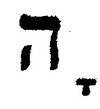Chapter 4 - Hebrew Nouns Flashcards
What are the masculine singular noun endings?
No set pattern (endingless).
What is the masculine plural noun ending?

What is the masculine dual noun ending?

What are the feminine plural noun endings?

What is the feminine plural noun ending?

What are the feminine plural dual endings?

Identify:

Feminine singular noun
Identify:

Feminine singular noun
Identify:

Feminine singular noun
Identify:

Feminine singular noun
Identify:

Feminine singular noun
Identify

Masculine plural noun
Identify:

Feminine plural noun
Identify:

Masculine dual noun
Identify:

Feminine dual noun
Identify:

Feminine dual noun
עִיר (city) and אֶבֶן (stone) are exeptions to the normal noun ending patterns because…
they are endingless feminine singular.
אָב Is an exception to the normal noun pluralisation pattern because…
though it is masculine singular, it takes the feminine plural ending
מַיִם (water) is an exception to the normal noun pluralisation pattern because…
it is always dual in form, but should usually be translated in the singular.
אִישׁ (man) does not follow the normal pattern of noun pluralisation because…
the stem of the word undergoes an irregular change. In this instance אִישׁ becomes אֲנָשִׁים
The 5 types of noun pluralisation are:
- Regular
- Propretonic
- Segholate
- Geminate
- Irregular
What is the tonic syllable?
The syllable that is accented within a word. Unless otherwise indicated, it is the last syllable.
What is the pretonic syllable?
The syllable before the tonic.
What is the propretonic syllable?
The syllable before the pretonic syllable.
How does defective spelling affect noun endings?
Sometimes, in the feminine plural, the Holem Vav becomes a just Holem on its own.
Shorter =defective spelling
Longer = plene (Latin for “full”)
Propretonic reduction occurs when…
- pluralising certain (two-syllable) nouns
- Compatible nouns are accented on the final syllable.
- Compatible nouns have either a Quamets or a Tsere in the first (pretonic) syllable.
Explain propretonic reduction!
- The Quamets or Tsere is placed in an open propretonic syllable
- The Quamets or Tsere will shorten to a (vocal) Shewa
What is the one exception to the expected pattern of propretonic reduction?
A word with an unchangable long vowel [Holem Vav (בּןֹ), Shureq (בּוּ), Seghol Yod (בֶּי), Tsere Yod (בֵּי), Hireq Yod (בִּי)] in the first syllable.
Segholate reduction occurs when…
- pluralising certain (two-syllable) nouns
- Compatible nouns are accented on the first syllable.
Explain segholate reduction!
- It’s called segholate reduction because this pattern of reduction affects nouns that typically have two Seghol vowels, sometimes just one Seghol vowel. It can occur in nouns that have no seghol vowels.
- The first vowel is shortened to either a (vocal) Shewa or a Hateph vowel.
- A Quamets is always placed under the second consonant.
Explain geminate pluralisation!
- Geminate nouns appear to have only 2 consonants.
- Originally, there would have been 3 with the second consonant repeating itself.
- When pluralised, the noun that would have originally repeated itself reappears in the form of a Dagesh Forte.


